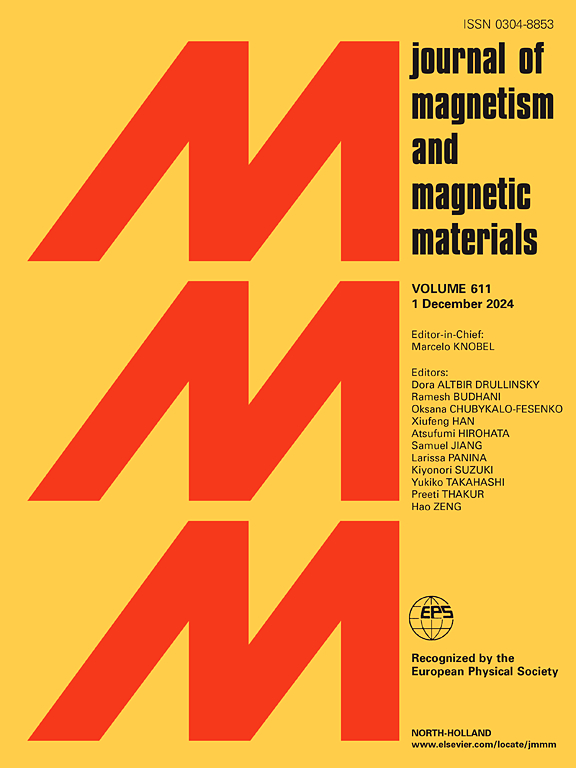The high entropy multi-component diffusion of Tb60Dy10Cu10Al10Zn10 effectively enhances the diffusion depth of heavy rare earths and coercivity in NdFeB magnets
IF 2.5
3区 材料科学
Q3 MATERIALS SCIENCE, MULTIDISCIPLINARY
引用次数: 0
Abstract
Grain boundary diffusion (GBD) magnets are essential for high-power density motors in applications like new energy vehicles and wind power. However, current GBD magnets face challenges such as limited diffusion depth and low heavy rare earth (HRE) utilization, hindering their development. In this study, magnetron sputtering was used to deposit 10 μm thick quinary Tb60Dy10Cu10Al10Zn10, binary Tb70Cu30, and Tb diffusion layers on commercial 52H magnets. After diffusion heat treatment, GBD magnets were produced. Magnetic tests showed that coercivity increased from 16.72 kOe to 23.53kOe, 22.02 kOe, and 22.03 kOe for the quinary, binary, and Tb diffusion magnets, respectively. The quinary diffusion magnet achieved 22.23 kOe/wt% HRE, significantly higher than 16.85 kOe/wt% HRE and 14.67 kOe/wt% HRE for Tb70Cu30 and Tb diffusion magnets. Microstructural analysis revealed that, compared to binary TbCu and Tb diffusion magnets, the HRE-rich shell and thin grain boundary phase in the quinary diffusion magnet extended further along the diffusion direction, leading to high coercivity. Quantitative Tb analysis confirmed that quinary alloy diffusion enhances HRE diffusion depth. We propose that higher entropy in multi-component diffusion sources lowers Gibbs free energy, preventing HRE from entering main phase grains, thus improving diffusion depth and HRE utilization. Multi-component diffusion is a promising approach for high-performance GBD NdFeB magnets. Our study offers valuable insights for advancing GBD magnets.
晶界扩散(GBD)磁体对于新能源汽车和风力发电等应用中的高功率密度电机至关重要。然而,目前的 GBD 磁体面临着扩散深度有限和重稀土(HRE)利用率低等挑战,阻碍了其发展。本研究采用磁控溅射技术在商用 52H 磁体上沉积 10 μm 厚的二元 Tb60Dy10Cu10Al10Zn10、二元 Tb70Cu30 和 Tb 扩散层。经过扩散热处理后,生产出了 GBD 磁体。磁性测试表明,二元、二元和铽扩散磁体的矫顽力分别从 16.72 kOe 增加到 23.53kOe、22.02 kOe 和 22.03 kOe。二元扩散磁体达到了 22.23 kOe/wt% HRE,明显高于 Tb70Cu30 和 Tb 扩散磁体的 16.85 kOe/wt% HRE 和 14.67 kOe/wt% HRE。显微结构分析表明,与二元态 TbCu 和 Tb 扩散磁体相比,二元扩散磁体中富含 HRE 的外壳和薄晶界相沿扩散方向延伸得更远,从而导致了高矫顽力。钽定量分析证实,二元合金扩散增强了 HRE 扩散深度。我们认为,多组分扩散源中较高的熵降低了吉布斯自由能,阻止了 HRE 进入主相晶粒,从而提高了扩散深度和 HRE 利用率。多组分扩散是实现高性能 GBD NdFeB 磁体的一种可行方法。我们的研究为推动 GBD 磁体的发展提供了宝贵的见解。
本文章由计算机程序翻译,如有差异,请以英文原文为准。
求助全文
约1分钟内获得全文
求助全文
来源期刊

Journal of Magnetism and Magnetic Materials
物理-材料科学:综合
CiteScore
5.30
自引率
11.10%
发文量
1149
审稿时长
59 days
期刊介绍:
The Journal of Magnetism and Magnetic Materials provides an important forum for the disclosure and discussion of original contributions covering the whole spectrum of topics, from basic magnetism to the technology and applications of magnetic materials. The journal encourages greater interaction between the basic and applied sub-disciplines of magnetism with comprehensive review articles, in addition to full-length contributions. In addition, other categories of contributions are welcome, including Critical Focused issues, Current Perspectives and Outreach to the General Public.
Main Categories:
Full-length articles:
Technically original research documents that report results of value to the communities that comprise the journal audience. The link between chemical, structural and microstructural properties on the one hand and magnetic properties on the other hand are encouraged.
In addition to general topics covering all areas of magnetism and magnetic materials, the full-length articles also include three sub-sections, focusing on Nanomagnetism, Spintronics and Applications.
The sub-section on Nanomagnetism contains articles on magnetic nanoparticles, nanowires, thin films, 2D materials and other nanoscale magnetic materials and their applications.
The sub-section on Spintronics contains articles on magnetoresistance, magnetoimpedance, magneto-optical phenomena, Micro-Electro-Mechanical Systems (MEMS), and other topics related to spin current control and magneto-transport phenomena. The sub-section on Applications display papers that focus on applications of magnetic materials. The applications need to show a connection to magnetism.
Review articles:
Review articles organize, clarify, and summarize existing major works in the areas covered by the Journal and provide comprehensive citations to the full spectrum of relevant literature.
 求助内容:
求助内容: 应助结果提醒方式:
应助结果提醒方式:


